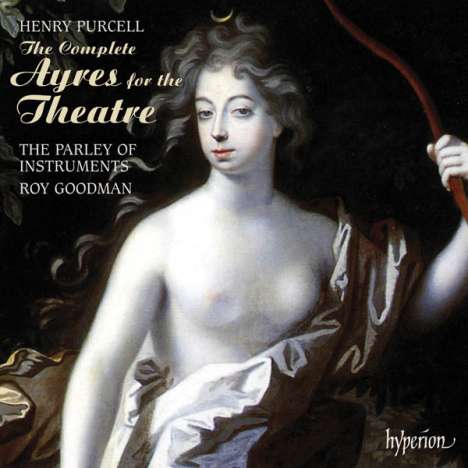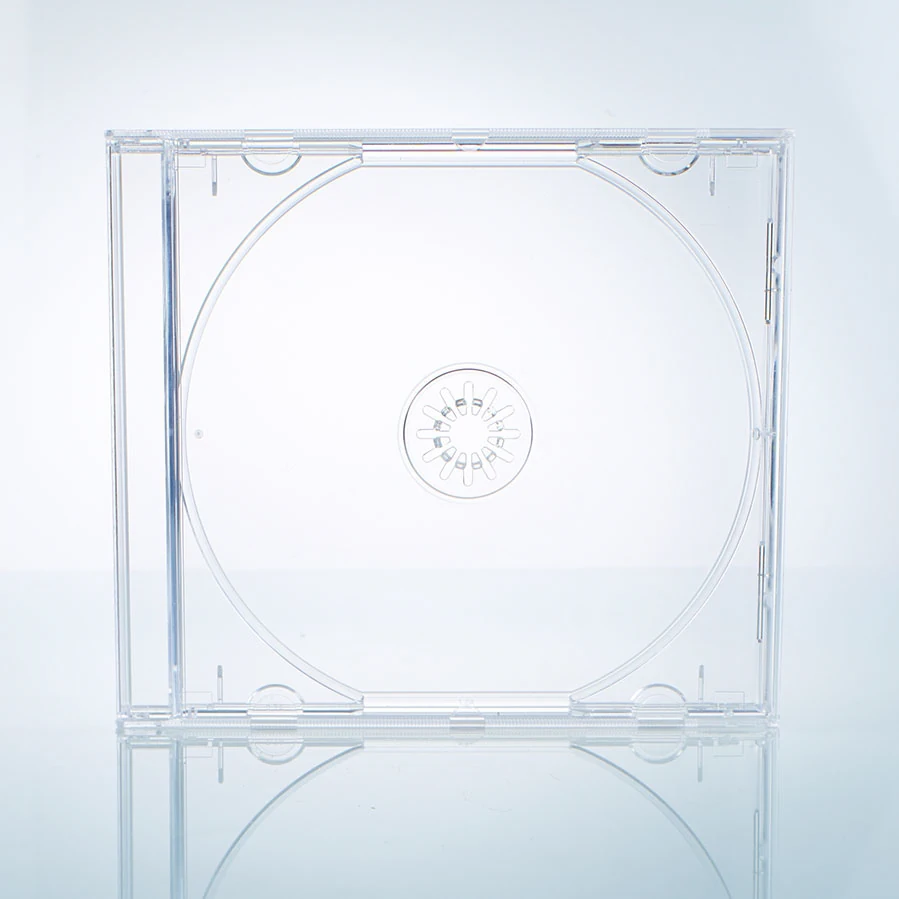Henry Purcell: Musik für das Theater (Ges.-Aufn.) auf 3 CDs
Musik für das Theater (Ges.-Aufn.)
Herkömmliche CD, die mit allen CD-Playern und Computerlaufwerken, aber auch mit den meisten SACD- oder Multiplayern abspielbar ist.
Lassen Sie sich über unseren eCourier benachrichtigen, falls das Produkt bestellt werden kann.
Prophetess; King Arthur; Fairy Queen; Indian Queen; Married Beau; Old Batchelor; Amphitryon; Double Dealer; Distressed Innocence; Gordian Knot Untied; Abdelazer; Bonduca; Virtuous Wife; Sonata 'While the Sun rises';Overture in g; Overture to Sir Anthony in Love; Timon of Athens; Symphony 'The Indian Queen'
- Künstler:
- The Parley of Instruments, Roy Goodman
- Label:
- Hyperion
- Aufnahmejahr ca.:
- 1994
- UPC/EAN:
- 0034571143811
- Erscheinungstermin:
- 25.9.2009
Ähnliche Artikel
Melodien für das Theater
Zwei Jahre nach Henry Purcells Tod 1695 erschien eine umfangreiche Sammlung unter dem Titel »A Collection of Ayres, Compos’d for the Theatre, and upon other Occasions«, kurz »Ayres for the Theatre«. Die vier Stimmbücher dieser »Melodien für das Theater« enthalten dreizehn Suiten, die zusammen mit einigen weiteren Stücken vom Ensemble »The Parley of Instruments« unter Roy Goodman zusammengestellt und interpretiert wurden, wie sie in einem Konzertrahmen der Purcell-Zeit erklungen sein könnten.
Product-Information:
When Henry Purcell died suddenly on 21 November 1695 he left a good deal of unpublished music. The music publishing industry was still relatively undeveloped in England during his lifetime and by and large only those pieces that could easily be performed in the home—songs, catches, trio sonatas and keyboard pieces—got into print. In fact, Purcell’s death stimulated a burst of unprecedented activity: his keyboard suites were published in A Choice Collection of Lessons for the Harpsichord or Spinnet (1696), a second set of trio sonatas was issued as Ten Sonata’s in Four Parts (1697), one of his most popular concerted works, the Te Deum and Jubilate in D major, was published in score in 1697, and a large collection of his songs appeared in the two volumes of Orpheus Britannicus (1698 and 1706).
The most unexpected of these memorial volumes was A Collection of Ayres, Compos’d for the Theatre, and upon other Occasions (1697). Ayres for the Theatre, as it was known for short, was the first printed collection devoted entirely to the incidental music used in the London theatres. It marked the point at which this repertory, hitherto largely confined to theatrical circles, was taken up in public concerts and in the home, and it was the model for a series of more than fifty theatre suites published by Walsh and Hare in the first decade of the eighteenth century. The four part-books of Ayres for the Theatre contain thirteen suites written by Purcell for the London theatres between June 1690 (Dioclesian) and the autumn of 1695 (Bonduca). Despite the mention of ‘other occasions’, the collection only seems to contain theatre music, and it includes all his known theatre suites: the ones for The Double Marriage, Timon of Athens and The Rival Sisters, included in earlier lists of Purcell’s works, are now thought to be by Louis Grabu, James Paisible and John Ridgley.
Rezensionen
'The Parley of Instruments up to their usual stellar form' (Stereophile, USA)
'Highly enjoyable!' (Early Music Review)
''Ayres for the Theatre' is a wonderful collection of rich and varied, tuneful music and has been marvellously well recorded by engineer Tony Faulkner … the players set out in almost holographic detail between, beyond, between and in front of the loudspeakers. You could almost be there' (Gramophone 'Soundings')
'Strongly recommended' (Fanfare, USA)
Rezensionen
FonoForum 11/1995: "Emphatische Interpretation, plakativ gezeichnete Kontraste und in ihrer vitalen Brillanz geradezu al fresco wirkend. Dies macht ein kontinuier- liches Durchhören der drei CDs sehr unterhaltsam und kurzweilig."Disk 1 von 3 (CD)
The Prophetess or The History Of Dioclesian Z 627 (1690) / Betterton Suite
-
1 Nr. 1 Overture
-
2 Nr. 2 Preludio
-
3 Nr. 3 Song Tune (Let The Soldiers Rejoice)
-
4 Nr. 4 Trumpet Tune
-
5 Nr. 5 Country Dance
-
6 Nr. 6 Air
-
7 Nr. 7 Hornpipe
-
8 Nr. 8 Air (Trumpet Tune)
-
9 Nr. 9 Canaries
King Arthur or The British Worthy Z 628 (1691) / Oper (Dryden) Suite
-
10 Nr. 1 Overture
-
11 Nr. 2 Air
-
12 Nr. 3 Air
-
13 Nr. 4 Song Tune (Fairest Isle)
-
14 Nr. 5 Hornpipe
-
15 Nr. 6 Hornpipe (Come, Shepherds)
-
16 Nr. 7 Song Tune (Howw Blest Are Shepherds)
-
17 Nr. 8 Air
-
18 Nr. 9 Song Tune (Round The Coasts)
-
19 Nr. 10 Song Tune (Come If You Dare)
-
20 Nr. 11 Trumpet Tune
-
21 Nr. 12 Trumpet Tune
-
22 Nr. 13 Chaconne
The Fairy Queen Z 629 (1692 / 93) / Oper in 5 Akten (nach Shakespeare: Ein Sommernachtstraum) Suiten I und II
-
23 Nr. 1 Overture
-
24 Nr. 2 Hornpipe
-
25 Nr. 3 Air
-
26 Nr. 4 Air
-
27 Nr. 5 Rondeau
-
28 Nr. 6 Preludio
-
29 Nr. 7 Hornpipe
-
30 Nr. 8 Overture (Symphony While The Swan Comes Forward)
-
31 Nr. 9 Song Tune (If Love's A Sweet Passion)
-
32 Nr. 10 Jig
-
33 Nr. 11 Dance For The Fairies
-
34 Nr. 12 Air 4 in 2 (Dance For The Followers Of Night)
-
35 Nr. 13 Song Tune (Sing While we Trip It)
-
36 Nr. 14 Air
-
37 Nr. 15 Air
-
38 Nr. 16 Song Tune (Thus Happy And Free)
-
39 Nr. 17 Chaconne (Dance For The Chinese Man And Woman)
-
40 Nr. 18 Air
The Indian Queen Z 630 (1695) / Oper in 5 Akten (Dryden und Hovland) Suite für Orchester
-
41 Nr. 1 Overture
-
42 Nr. 2 Trumpet Tune
-
43 Nr. 3 Trumpet Tune (I Come To Sing Great Zempoalla's Story)
-
44 Nr. 4 Air
-
45 Nr. 5 Hornpipe
-
46 Nr. 6 Air
-
47 Nr. 7 Hornpipe
-
48 Nr. 8 Air
-
49 Nr. 9 Song Tune (We The Spirits Of The Air)
-
50 Nr. 10 Rondeau
Disk 2 von 3 (CD)
The Married Beau or The Curious Impertinent Z 603 (1694) / Oper (Crowne) Suite (für Orchester d-moll)
-
1 Nr. 1 Overture
-
2 Nr. 2 Slow Air
-
3 Nr. 3 Hornpipe
-
4 Nr. 4 Air
-
5 Nr. 5 Hornpipe
-
6 Nr. 6 Jig
-
7 Nr. 7 Trumpet Air
-
8 Nr. 8 March
-
9 Nr. 9 Hornpipe On A Ground
The Old Batchelor Z 607 / Congreve Suite (für Orchester)
-
10 Nr. 1 Overture
-
11 Nr. 2 Hornpipe
-
12 Nr. 3 Slow Air
-
13 Nr. 4 Hornpipe
-
14 Nr. 5 Rondeau
-
15 Nr. 6 Minuet
-
16 Nr. 7 Borry
-
17 Nr. 8 March
-
18 Nr. 9 Jig
Amphitryon or The Two Sosias Z 572 (1690) (Bühnenmusik)
-
19 Nr. 1 Overture
-
20 Nr. 2 Sarabande
-
21 Nr. 3 Hornpipe
-
22 Nr. 4 Scotch Tune
-
23 Nr. 5 Air
-
24 Nr. 6 Minuet
-
25 Nr. 7 Hornpipe
-
26 Nr. 8 Borry (Or Gavotte)
Double Dealer Z 592 (1693) / W. Congreve Ausschnitte ( / Suite)
-
27 Nr. 1 Overture
-
28 Nr. 2 Hornpipe
-
29 Nr. 3 Minuet
-
30 Nr. 4 Air
-
31 Nr. 5 Hornpipe
-
32 Nr. 6 Minuet (Slow Air)
-
33 Nr. 7 Minuet
-
34 Nr. 8 Air
-
35 Nr. 9 Air
Distressed Innocence or The Princess Of Persia Z 577 (1690) / Settle Ausschnitte ( / Suite)
-
36 Nr. 1 Overture
-
37 Nr. 2 Air
-
38 Nr. 3 Slow Air
-
39 Nr. 4 Air
-
40 Nr. 5 Hornpipe (Or Jig)
-
41 Nr. 6 Rondeau
-
42 Nr. 7 Air
-
43 Nr. 8 Minuet
The Gordian Knot Untied Z 597 (1690) / Southern Suite (für Orchester)
-
44 Nr. 1 Overture
-
45 Nr. 2 Air
-
46 Nr. 3 Rondeau Minuet
-
47 Nr. 4 Air
-
48 Nr. 5 Jig (Lilliburlero)
-
49 Nr. 6 Chaconne
-
50 Nr. 7 Air
-
51 Nr. 8 Minuet
Disk 3 von 3 (CD)
Abdelazer oder Die Rache des Mohren Z 570 (1695) / Benn Suite (für Orchester)
-
1 Nr. 1 Overture
-
2 Nr. 2 Rondeau (Hornpipe)
-
3 Nr. 3 Air
-
4 Nr. 4 Air
-
5 Nr. 5 Minuet
-
6 Nr. 6 Air
-
7 Nr. 7 Jig
-
8 Nr. 8 Hornpipe
-
9 Nr. 9 Air
Bonduca or The British Heroine Z 574 (1695) / Bühnenmusik (Fletcher) Ausschnitte ( / Suite)
-
10 Nr. 1 Overture
-
11 Nr. 2 Song Tune (Britons, Strike Home)
-
12 Nr. 3 Song Tune (To Arms, To Arms)
-
13 Nr. 4 Air
-
14 Nr. 5 Hornpipe
-
15 Nr. 6 Air
-
16 Nr. 7 Hornpipe
-
17 Nr. 8 Air
-
18 Nr. 9 Minuet
The Virtuous Wife or Good Luck At Last Z 611 / D'Urfey Suite (für Orchester)
-
19 Nr. 1 Overture
-
20 Nr. 2 Song Tune (Ah, How Sweet It Is To Love)
-
21 Nr. 3 Slow Air
-
22 Nr. 4 Air
-
23 Nr. 4 Preludio
-
24 Nr. 5 Hornpipe
-
25 Nr. 6 Minuet
-
26 Nr. 7 Minuet
-
27 Nr. 8 Air (La Furstenburg)
The Fairy Queen Z 629 (1692 / 93) / Oper in 5 Akten (nach Shakespeare: Ein Sommernachtstraum) Sonata While The Sun Rises
-
28 1. Satz: (Allegro)
-
29 2. Satz: Canzona
-
30 3. Satz: Adagio
-
31 4. Satz: (Allegro)
-
32 Dido And Aeneas Z 626 (1689) / Oper in 3 Akten (Tate) Ouvertüre
-
33 Sir Anthony Love or The Rambling Lady Z 588 / Bühnenmusik Ouvertüre
-
34 Timon Of Athens or The Man-Hater Z 632 (1694 / 95) / Shadwell Nr. 1 (Ouvertüre)
-
35 Timon Of Athens or The Man-Hater Z 632 (1694 / 95) / Shadwell Nr. 20 (The Curtain Tune, for strings)
-
36 The Indian Queen Z 630 (1695) / Oper in 5 Akten (Dryden und Hovland) Sinfonie (2. Akt)
Mehr von Henry Purcell
-
Henry PurcellOde for the Birthday of Queen Mary "Hail! Bright Cecilia"CDAktueller Preis: EUR 17,99
-
Henry PurcellSerenading Songs & GroundsCDAktueller Preis: EUR 19,99
-
Henry PurcellSämtliche Kammermusik7 CDsVorheriger Preis EUR 34,99, reduziert um 0%Aktueller Preis: EUR 19,99
-
Oxford New College Choir - The Restoration & Georgian Anthems5 CDsAktueller Preis: EUR 39,99










